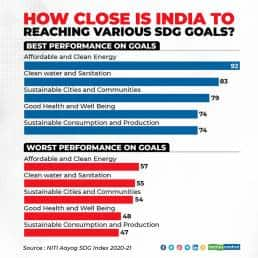



There is both good and bad news.
In a COVID-19 pandemic-hit 2020, India improved its score in the United Nations’ Sustainability Development Goals (SDG) Index, including a substantial rise in healthcare parameters.
It, however, saw a drop in score for goals like ‘decent work and economic growth’ and ‘industry, innovation and infrastructure’, as per the latest SDG data released by the Niti Aayog on June 3.
In 2020-21, Kerala and Bihar retained their top and bottom ranks, respectively, in the Niti Aayog's SDG India Index 2020-21, which measures the progress of states and Union Territories (UTs) on social, economic, and environmental parameters.
The Third Edition of the Index tracks the progress of all the states and Union Territories on a set of 17 global goals, which are broken down into 70 targets, and 115 national development indicators derived from the National Indicator Framework, measuring their progress on the outcomes of interventions and schemes of the central government.
According to the NITI Aayog, India's overall score increased to 66 in 2020, up from 60 in 2019. The pace of improvement was greater than the year before, when the national score had progressed from 57 to 60.
“The country’s overall SDG score improved by 6 points—from 60 in 2019 to 66 in 2020–21. This positive stride towards achieving the targets is largely driven by exemplary country-wide performance in Goal 6 (Clean Water and Sanitation) and Goal 7 (Affordable and Clean Energy), where the composite Goal scores are 83 and 92, respectively,” Niti Aayog said in a statement.
 India's performance in reaching the 17-UN backed global sustainable development goals remain mixed.
India's performance in reaching the 17-UN backed global sustainable development goals remain mixed.
Gains in health sector
For the health sector (Good Health and Well Being), India’s score went up to 74 from 61, based on parameters like reducing infant mortality rates and epidemics like AIDs and tuberculosis, and increasing health sector financing and staffing of doctors, nurses and other medical professionals.
Under the health sector goals, Gujarat, Maharashtra and Tamil Nadu were the best performing sectors while Chhattisgarh, Uttar Pradesh and Assam were the worst performing.
Hit by the pandemic, India lost ground in ‘decent work and economic growth’ and ‘industry, innovation and infrastructure’.
In the former it scored 61 points compared to 64 last year and 55 compared to 65 last year in the latter.
The SDG Index aims to support states to assess their progress against national targets and the performance of their peers to better understand the reasons behind such differences in performance, and thereby devise better strategies to achieve the SDGs by 2030.
It has also been crucial in identifying priority areas in which states need to invest and improve by enabling them to measure incremental progress.
The SDG Index for 2020-21 was earlier set to be launched in early-March but was postponed due to the imposition of the Election Commission’s Model Code of Conduct and polls in five states.
 The list of states dominating the top and bottom of the index have remained the same since 2019-20.
The list of states dominating the top and bottom of the index have remained the same since 2019-20.
Global targets
The 17 interlinked global goals were set up in 2015 by the United Nations General Assembly and are designed to be a "blueprint to achieve a better and more sustainable future for all humanity".
Aimed at reducing hunger, poverty, gender disparity and pollution, among others, these goals are intended to be achieved by the year 2030.
The UN had earlier established the 8-Millennium Development Goals, adopted at the UN's Millennium Summit in 2000, that was set to be achieved by 2015.
But its legacy is disputed since it placed the onus of improvement on emerging and developing nations. The SDGs cover all nations.
These scores are apart from what the Niti Aayog assigns to India and the states.
As per the global report, with a score of 61.9, India stands at 117th rank globally as of 2020, according to the Sustainable Development Report 2020 that covers all 193 UN member states.
It is published by German think tank, Bertelsmann Stiftung.
In the subcontinent, Bangladesh is ahead of India at the 109th rank, with a score of 63.5.
According to the report, India has made strides in poverty alleviation, clean water and sanitation, decent work and economic growth and climate action. However, it has slipped on life on land.
Discover the latest Business News, Sensex, and Nifty updates. Obtain Personal Finance insights, tax queries, and expert opinions on Moneycontrol or download the Moneycontrol App to stay updated!